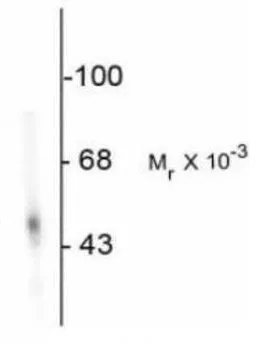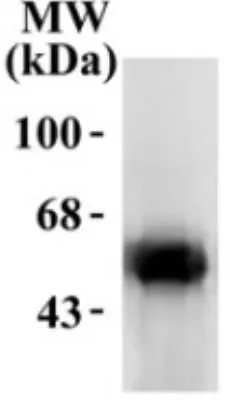
WB analysis of mouse cerebellum tissue lysate using GTX30448 DOPA Decarboxylase antibody.
DOPA Decarboxylase antibody
GTX30448
ApplicationsImmunoFluorescence, Western Blot, ImmunoCytoChemistry, ImmunoHistoChemistry, ImmunoHistoChemistry Frozen, ImmunoHistoChemistry Paraffin
Product group Antibodies
ReactivityBovine, Human, Mouse, Rat
TargetDDC
Overview
- SupplierGeneTex
- Product NameDOPA Decarboxylase antibody
- Delivery Days Customer9
- Application Supplier NoteWB: 1:1000. IHC-P: 1:10 - 1:500. IHC: 1:10 - 1:500. *Optimal dilutions/concentrations should be determined by the researcher.Not tested in other applications.
- ApplicationsImmunoFluorescence, Western Blot, ImmunoCytoChemistry, ImmunoHistoChemistry, ImmunoHistoChemistry Frozen, ImmunoHistoChemistry Paraffin
- CertificationResearch Use Only
- ClonalityPolyclonal
- ConjugateUnconjugated
- Gene ID280762
- Target nameDDC
- Target descriptiondopa decarboxylase
- Target synonymsAADC; aromatic-L-amino-acid decarboxylase; dopa decarboxylase (aromatic L-amino acid decarboxylase)
- HostRabbit
- IsotypeIgG
- Protein IDP27718
- Protein NameAromatic-L-amino-acid decarboxylase
- Scientific DescriptionCatalyzes the decarboxylation of L-3,4-dihydroxyphenylalanine (DOPA) to dopamine, L-5-hydroxytryptophan to serotonin and L-tryptophan to tryptamine.
- ReactivityBovine, Human, Mouse, Rat
- Storage Instruction-20°C or -80°C,2°C to 8°C
- UNSPSC12352203
References
- A Transcription Factor Etv1/Er81 Is Involved in the Differentiation of Sweet, Umami, and Sodium Taste Cells.Read more
- Sodium-Taste Cells Require Skn-1a for Generation and Share Molecular Features with Sweet, Umami, and Bitter Taste Cells. Ohmoto M et al., 2020 Nov/Dec, eNeuroRead more
- SOX2 regulates homeostasis of taste bud cells and lingual epithelial cells in posterior tongue. Ohmoto M et al., 2020, PLoS OneRead more
- Sodium Imbalance in Mice Results Primarily in Compensatory Gene Regulatory Responses in Kidney and Colon, but Not in Taste Tissue. Lossow K et al., 2020 Apr 3, NutrientsRead more
- Segregated Expression of ENaC Subunits in Taste Cells. Lossow K et al., 2020 May 21, Chem SensesRead more
- Mash1-expressing cells could differentiate to type III cells in adult mouse taste buds. Takagi H et al., 2018 Sep, Anat Sci IntRead more
- A large increase of sour taste receptor cells in Skn-1-deficient mice does not alter the number of their sour taste signal-transmitting gustatory neurons. Maeda N et al., 2017 May 1, Neurosci LettRead more
- Bcl11b/Ctip2 is required for development of lingual papillae in mice. Nishiguchi Y et al., 2016 Aug 1, Dev BiolRead more
- Cre-Mediated Recombination in Tas2r131 Cells-A Unique Way to Explore Bitter Taste Receptor Function Inside and Outside of the Taste System. Voigt A et al., 2015 Nov, Chem SensesRead more
- Transsynaptic Tracing from Taste Receptor Cells Reveals Local Taste Receptor Gene Expression in Gustatory Ganglia and Brain. Voigt A et al., 2015 Jul 1, J NeurosciRead more


